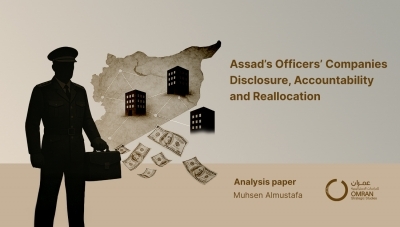Media Appearance
Early Economic Recovery in Opposition Controlled Areas between 2018 -2022
Introduction and Methodology
Early economic recovery aims to support local communities in returning to a stable and normal life, including preventing the community from returning to violence. The Early Recovery Report monitors projects implemented over a period of six months and is issued semi-annually, focusing on the main cities and towns in the "Euphrates Shield","Afrin" and Idlib governorate, which is witnessing remarkable economic activity, within 11 sectors which are: social services, transportation, electricity, water and sanitation, housing and construction, agriculture and livestock, finance, industry, trade, internal displacement, and communications.
The report relied on the official identifiers of local councils and organizations operating on Facebook and Telegram. The data was analyzed according to two levels, the first at the level of economic sectors, and the second by geographical level. Among the monitored areas in the countryside of Aleppo: Marea, A'zaz, al-Bab, Jarabulus, Akhtarin, Qabasin, Bza'a, Afrin, and Al Atarib. In Idlib Governorate: Idlib, Harem, Sarmada, Ma'arrat Misrin, Hazano, Salqin, Armanaz, Termanin, Atme, Al-Dana, Kah, Deir Hassan.
The report aims to analysis and understand the following:
- Monitor the dynamics of the activities and works carried out in the region, thus measuring the development of local economies, and comparing regions and sectors with each other.
- Exploring the ability of local and international actors to create a safe environment for living and working, and the ability of local councils to play a governance role and sign memoranda of understanding with companies and organizations that contribute to providing with the necessary projects.
Distribution of Projects According to Sectors
Overall, 5,024 projects were implemented in the countryside of Aleppo and Idlib between 2018 to 2022 through eleven economic sectors. The number of projects rose slowly with 338 projects in the second half of 2018 to 954 projects in the first half 2022 as shown in Figure No. (1) below.
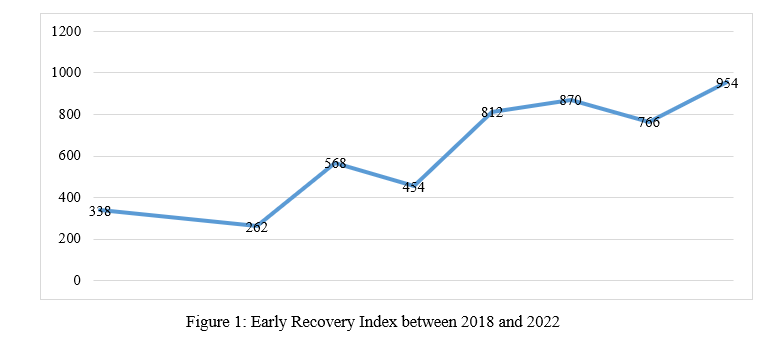
The highest percentage of projects were implemented in the transportation sector compared to the other sectors, as shown in Figure No. (2). These projects mainly contributed to the restoration of main and secondary roads destroyed by the war. These roads were vital to connecting villages and cities and facilitating civilian movement and trade. Water, sanitation, and trade projects came in second and third with 17% each, and the internal displacement sector ranked fourth at 13%.
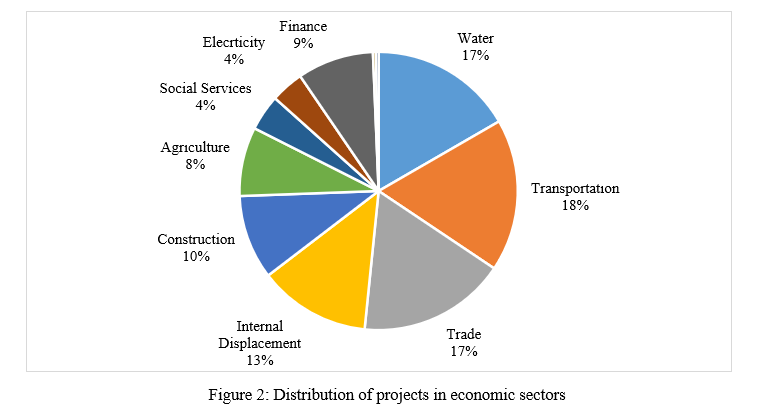
In more detail, Table No. (1) shows the sectoral survey on recovery projects during the observed period, where 891 projects were implemented in the transportation sector, 865 projects in the trade sector, followed by the water and sanitation sector with 837 projects. These projects were central to the recovery process in the region as they extended new water and sewage networks, repaired old networks, performed periodic maintenance, and repaired faults if they occur, such as paving roads, sidewalks, and commercial markets with asphalt and stone. Although these projects are still referred to as relief, they supported 1,293 camps, with a massive number of internally displaced persons, to access support and services. Projects related to construction were relatively low, around 487 projects were implemented, that included residential complexes for those displaced and the issuing of licenses for commercial and residential buildings. Agriculture projects were also lower, as farmers are reluctant to farm, there were only 403 projects during the observed period. The industrial, communications, and finance sectors are also suffering at the bottom of the index, due to the security situation and lack of investment in the region.

Distribution of Projects According to Regions
Figure No. 3 shows the distribution of projects between the countryside of Aleppo and Idlib between 2018 and 2022. The countryside of Aleppo had the largest percentage of projects with 55% about 2,757 projects were implemented in many towns and cities, most notably Azaz, Al-Bab, Afrin, Jarablus, Qabasin, Bza’a, Marea and others. The remaining 2,267 were executed in Idlib, Sarmada, Dana, Atma, Harem and others in Idlib governence.
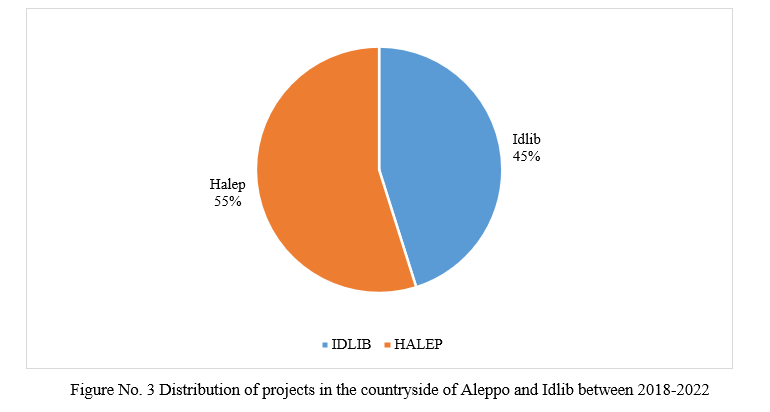
Table No. 2 shows the detailed distribution of projects at the level of towns and cities, where the city of Idlib appears at the top of the index with 669 projects, most of them in the sectors of internal displacement and trade. The city of Al-Bab, in the countryside of Aleppo ranked second with 598 projects in the sectors of housing, construction, trade, water and sanitation, and then Azaz with 475 projects in the sectors of water, transport, and electricity. A number of factors contributed to the discrepancy in the number of projects in cities and towns, including population density, displaced people and organizations, the centrality and importance of some cities before the revolution, the location of towns and cities on trade lines or near crossings, security situation, and lastly the concentration capital in some cities more than others.
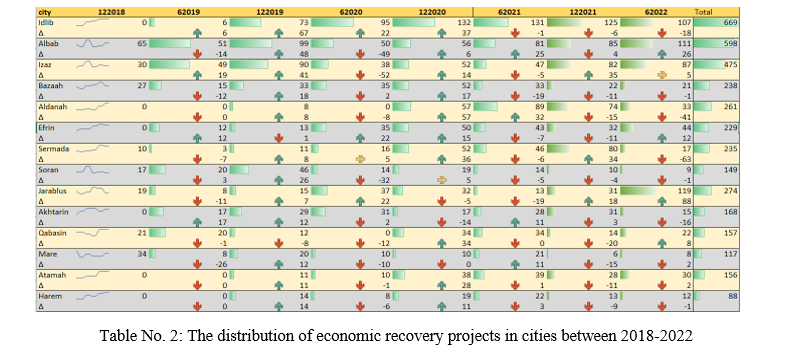
Recommendations
Local councils and organizations have implemented important projects that pushed the early economic recovery process forward. Indicators of stability are also more apparent than before. With over four years of monitoring economic recovery activities, reports have highlighted the strengthened national negotiation papers while contracting investment companies to bring in investments. Furthermore, the industry, agriculture, communications, and finance sectors remain a significant challenge in the region’s recovery and attracting funds and investments. This is due to the lack of policies and laws necessary to enhance confidence in the local economy and products, the shortage of raw materials, high prices of raw materials, and the decline in purchasing power, in addition to the fact that the region remains trapped in relief projects.
Among the report's recommendations is to support local councils with good governance policies and implementation within each sector. This would ensure and support workflow, helping them be more attractive for investments. Support in the financial sector would revitalize the other sectors and create a comprehensive identity for the region within the agricultural and industrial sectors. As a result employment oppoturnities would increase, thus supporting residents with more jobs and a sustainabile livelihood.
Economic Recovery in Syria: Mapping Actors and Assessing Current Policies
Introduction
The conflict in Syria that has been dragging on since 2011 generated many challenges that began to take shape as the conflict is coming to an end. Some of the key challenges pertain to early economic recovery which has already started in the various areas of the country, with their different influences, needs, resources and potentials. Given the current situation in Syria—with the consolidation of zones of influence and the faltering political process -local, regional, and international policies have begun to adapt to this reality, with key stakeholders launching early economic recovery projects in the established zones of influence.
The political and military landscape in Syria remains precarious and questions of the capacity of different actors, reality of these regions and the political context pertaining to economic recovery in these areas must be addressed in order for stakeholders to successfully implement early recovery projects. Accordingly, the Omran Center for Strategic Studies has developed a research series to understand the dynamics, political compass, requirements, and challenges of these early recovery projects so for them to facilitate the establishment of stability on the ground.
Early recovery is critical because it is the phase that is supposed to transition the country from conflict to peace and stability and lay the foundation for the subsequent reconstruction process. This phase has political and social dimensions that are of equal importance to its economic dimension. The political dimension involves working to stop violence throughout the country, establishing new governance institutions, and reaching a political solut3. Autonomous Administrationion that generates stability. The social dimension includes relief work, accommodations and housing for refugees, and national reconciliation after the preparation of an appropriate security environment. The economic dimension includes the restoration of basic public utilities, relaunching of the economy moving, rebalancing the macroeconomic framework, and dismantling the components of the conflict economy in areas both outside of and under state control. The above political, social, and economic elements are significantly intertwined and success in any one area depends on success in the other two.
The research orientation of Omran Center assumes that the coming phase in Syria will take place in a military post-conflict setting and that a most likely scenario to play out will be one of two: The first scenario is the instilment of the zones of influence: a ‘useful Syria’ with Iranian and Russian influence, eastern Syria with Western-Arab influence, and northern Syria with Turkish influence. The second scenario is continued investment in the ceasefire by regional and international actors, with priority placed on declared or undeclared negotiations to reach a new form of authority in which the existing regime maintains the largest share, thanks both to the efforts of its allies and the regime’s success in retaining the mechanisms of control.
The overall objectives of the research orientation of Omran Center are to identify criteria for an effective early economic recovery that is conducive to stability and development and to create a policy framework for implementing those recovery efforts. This research also aims to define the requirements and conditions for early recovery as they relate to security, governance, and development and to reach a position regarding the regime’s ability to handle Syria’s post-conflict challenges and to implement recovery and reconstruction policies. In this context, Omran has produced five reports:
1. A political analysis paper on the political context of early recovery in Syria;
2. An analytical paper of early economic recovery in Syria: challenges and priorities;
3. A paper on the political economy of early recovery in Syria;
4. A study on Early Recovery in Syria: An Assessment of the Regime’s Role and Capability; and 5. A study on the Turkish approach to early economic recovery in Syria, Euphrates Shield area as a case study.
For More Click Here: http://bit.ly/2lHvGit
Note of Appreciation
Omran for Strategic Studies expresses its gratitude for support received from Konrad-Adenauer-Stiftung.

